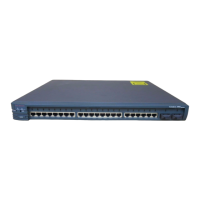Chapter 10: Server Load Balancing (SLB) 149
Section 10-1
■ IOS SLB can also operate as a Dynamic Feedback Protocol (DFP) load-balancing
manager. The DFP manager collects capacity information from DFP agents running
on the real servers.
Configuration
1. Define a server farm.
a. Assign a name to the server farm:
(global) ip slb serverfarm serverfarm-name
The server farm is identified by serverfarm-name (text string up to 15 charac-
ters).
b. (Optional) Select a load-balancing algorithm for the server farm:
(server-farm) predictor {roundrobin | leastconns}
SLB selects a real server using roundrobin (weighted round-robin the default) or
leastconns (weighted least connections).
c. (Optional) Use server NAT:
(server-farm) nat server
By default, the virtual server and real server addresses must be Layer 2-adjacent.
In other words, SLB forwards packets between the virtual server and a real server
by substituting the correct MAC addresses. Server NAT can be used instead,
allowing the virtual and real servers to have addresses from separate IP subnets.
SLB then substitutes the Layer 3 IP addresses to forward packets between the
virtual and real servers, allowing the servers to be separated by multiple routing
hops.
d. (Optional) Use client NAT.
■ Define a NAT pool of addresses:
(global) ip slb natpool pool-name start-ip end-ip {netmask netmask |
prefix-length leading-1-bits}[entries init-addr [max-addr]]
A pool of IP addresses is given the name pool-name (text string up to 15 char-
acters), consisting of addresses bounded by start-ip and end-ip. The subnet
mask associated with the pool can be given as a regular subnet mask, netmask
(x.x.x.x format), or as the number of leading 1 bits in the mask, leading-1-bits
(1 to 32).
For IOS SLB, client NAT allocates a number of entries as IP addresses and port
numbers, init-addr (1 to 1,000,000; default 8000) as an initial set to use. When
the number of dynamically allocated entries reaches half of the initial number,
more entries are allocated. The maximum number of NAT entries can be
defined as max-addr (1 to 8,000,000; default is the pool size times the number
of ports available, or 65,535 to 11,000, or 54,535). Port numbers for transla-
tion begin at 11,000.
